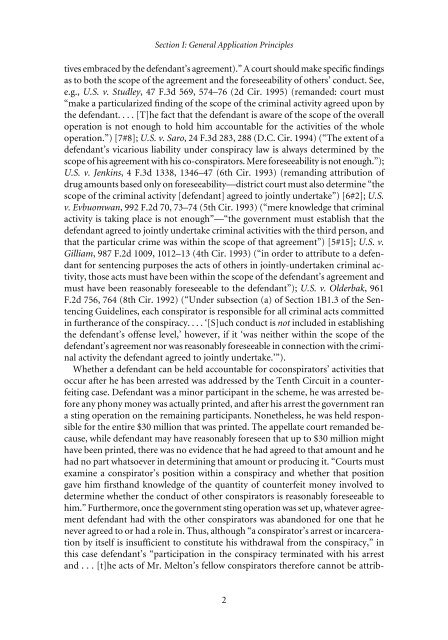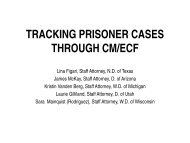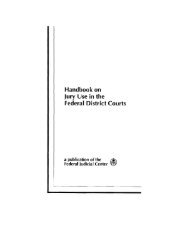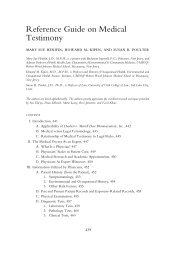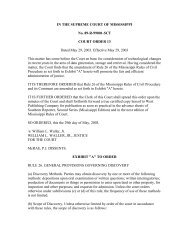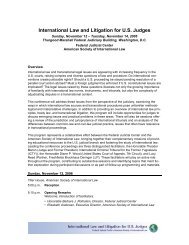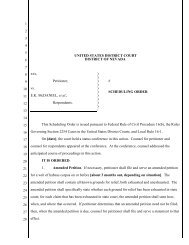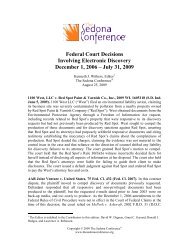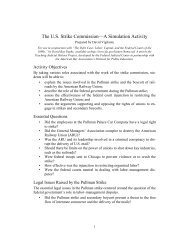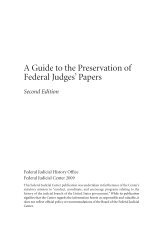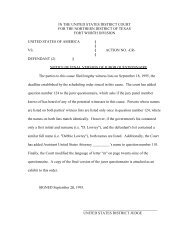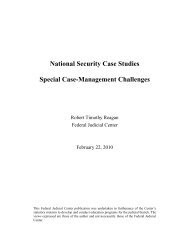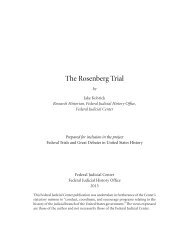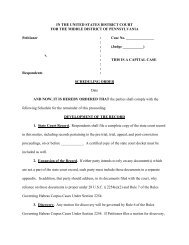Guideline Sentencing: An Outline of Appellate Case Law on ...
Guideline Sentencing: An Outline of Appellate Case Law on ...
Guideline Sentencing: An Outline of Appellate Case Law on ...
You also want an ePaper? Increase the reach of your titles
YUMPU automatically turns print PDFs into web optimized ePapers that Google loves.
Secti<strong>on</strong> I: General Applicati<strong>on</strong> Principles<br />
tives embraced by the defendant’s agreement).” A court should make specific findings<br />
as to both the scope <str<strong>on</strong>g>of</str<strong>on</strong>g> the agreement and the foreseeability <str<strong>on</strong>g>of</str<strong>on</strong>g> others’ c<strong>on</strong>duct. See,<br />
e.g., U.S. v. Studley, 47 F.3d 569, 574–76 (2d Cir. 1995) (remanded: court must<br />
“make a particularized finding <str<strong>on</strong>g>of</str<strong>on</strong>g> the scope <str<strong>on</strong>g>of</str<strong>on</strong>g> the criminal activity agreed up<strong>on</strong> by<br />
the defendant. . . . [T]he fact that the defendant is aware <str<strong>on</strong>g>of</str<strong>on</strong>g> the scope <str<strong>on</strong>g>of</str<strong>on</strong>g> the overall<br />
operati<strong>on</strong> is not enough to hold him accountable for the activities <str<strong>on</strong>g>of</str<strong>on</strong>g> the whole<br />
operati<strong>on</strong>.”) [7#8]; U.S. v. Saro, 24 F.3d 283, 288 (D.C. Cir. 1994) (“The extent <str<strong>on</strong>g>of</str<strong>on</strong>g> a<br />
defendant’s vicarious liability under c<strong>on</strong>spiracy law is always determined by the<br />
scope <str<strong>on</strong>g>of</str<strong>on</strong>g> his agreement with his co-c<strong>on</strong>spirators. Mere foreseeability is not enough.”);<br />
U.S. v. Jenkins, 4 F.3d 1338, 1346–47 (6th Cir. 1993) (remanding attributi<strong>on</strong> <str<strong>on</strong>g>of</str<strong>on</strong>g><br />
drug amounts based <strong>on</strong>ly <strong>on</strong> foreseeability—district court must also determine “the<br />
scope <str<strong>on</strong>g>of</str<strong>on</strong>g> the criminal activity [defendant] agreed to jointly undertake”) [6#2]; U.S.<br />
v. Evbuomwan, 992 F.2d 70, 73–74 (5th Cir. 1993) (“mere knowledge that criminal<br />
activity is taking place is not enough”—“the government must establish that the<br />
defendant agreed to jointly undertake criminal activities with the third pers<strong>on</strong>, and<br />
that the particular crime was within the scope <str<strong>on</strong>g>of</str<strong>on</strong>g> that agreement”) [5#15]; U.S. v.<br />
Gilliam, 987 F.2d 1009, 1012–13 (4th Cir. 1993) (“in order to attribute to a defendant<br />
for sentencing purposes the acts <str<strong>on</strong>g>of</str<strong>on</strong>g> others in jointly-undertaken criminal activity,<br />
those acts must have been within the scope <str<strong>on</strong>g>of</str<strong>on</strong>g> the defendant’s agreement and<br />
must have been reas<strong>on</strong>ably foreseeable to the defendant”); U.S. v. Olderbak, 961<br />
F.2d 756, 764 (8th Cir. 1992) (“Under subsecti<strong>on</strong> (a) <str<strong>on</strong>g>of</str<strong>on</strong>g> Secti<strong>on</strong> 1B1.3 <str<strong>on</strong>g>of</str<strong>on</strong>g> the <str<strong>on</strong>g>Sentencing</str<strong>on</strong>g><br />
<str<strong>on</strong>g>Guideline</str<strong>on</strong>g>s, each c<strong>on</strong>spirator is resp<strong>on</strong>sible for all criminal acts committed<br />
in furtherance <str<strong>on</strong>g>of</str<strong>on</strong>g> the c<strong>on</strong>spiracy. . . . ‘[S]uch c<strong>on</strong>duct is not included in establishing<br />
the defendant’s <str<strong>on</strong>g>of</str<strong>on</strong>g>fense level,’ however, if it ‘was neither within the scope <str<strong>on</strong>g>of</str<strong>on</strong>g> the<br />
defendant’s agreement nor was reas<strong>on</strong>ably foreseeable in c<strong>on</strong>necti<strong>on</strong> with the criminal<br />
activity the defendant agreed to jointly undertake.’”).<br />
Whether a defendant can be held accountable for coc<strong>on</strong>spirators’ activities that<br />
occur after he has been arrested was addressed by the Tenth Circuit in a counterfeiting<br />
case. Defendant was a minor participant in the scheme, he was arrested before<br />
any ph<strong>on</strong>y m<strong>on</strong>ey was actually printed, and after his arrest the government ran<br />
a sting operati<strong>on</strong> <strong>on</strong> the remaining participants. N<strong>on</strong>etheless, he was held resp<strong>on</strong>sible<br />
for the entire $30 milli<strong>on</strong> that was printed. The appellate court remanded because,<br />
while defendant may have reas<strong>on</strong>ably foreseen that up to $30 milli<strong>on</strong> might<br />
have been printed, there was no evidence that he had agreed to that amount and he<br />
had no part whatsoever in determining that amount or producing it. “Courts must<br />
examine a c<strong>on</strong>spirator’s positi<strong>on</strong> within a c<strong>on</strong>spiracy and whether that positi<strong>on</strong><br />
gave him firsthand knowledge <str<strong>on</strong>g>of</str<strong>on</strong>g> the quantity <str<strong>on</strong>g>of</str<strong>on</strong>g> counterfeit m<strong>on</strong>ey involved to<br />
determine whether the c<strong>on</strong>duct <str<strong>on</strong>g>of</str<strong>on</strong>g> other c<strong>on</strong>spirators is reas<strong>on</strong>ably foreseeable to<br />
him.” Furthermore, <strong>on</strong>ce the government sting operati<strong>on</strong> was set up, whatever agreement<br />
defendant had with the other c<strong>on</strong>spirators was aband<strong>on</strong>ed for <strong>on</strong>e that he<br />
never agreed to or had a role in. Thus, although “a c<strong>on</strong>spirator’s arrest or incarcerati<strong>on</strong><br />
by itself is insufficient to c<strong>on</strong>stitute his withdrawal from the c<strong>on</strong>spiracy,” in<br />
this case defendant’s “participati<strong>on</strong> in the c<strong>on</strong>spiracy terminated with his arrest<br />
and . . . [t]he acts <str<strong>on</strong>g>of</str<strong>on</strong>g> Mr. Melt<strong>on</strong>’s fellow c<strong>on</strong>spirators therefore cannot be attrib-<br />
2


